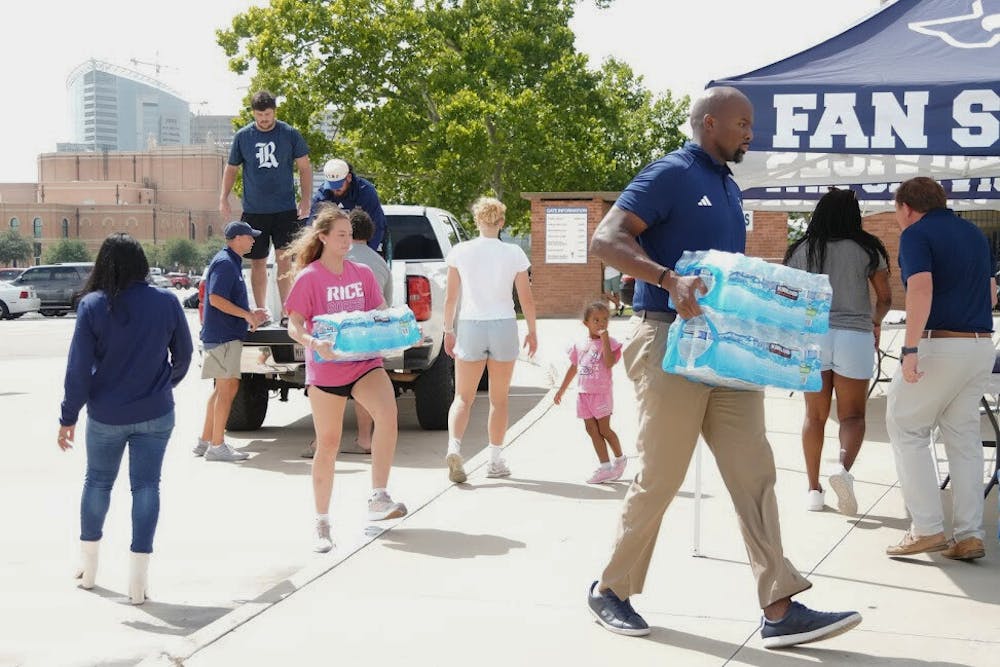Rice community, experts lend support to Kerrville after deadly floods

Rice Athletics staff carries donations for the victims of the recent Hill Country floods. The department hosted a community donation drive July 10-11.
Courtesy Kat Cosley Trigg
In the early hours of the morning on July 4, flood waters rapidly rose the Guadalupe River to 30 feet above its normal height. One of the few gauges on the river failed. Young girls sleeping in the cabins of Camp Mystic on the banks of the river had no phones to receive the flood warnings.
The July 4 floods in the Texas Hill Country have claimed 135 lives thus far.
Bruce Hurley, a Lovett college junior, said he knew Chloe Childress, a Camp Mystic counselor who died in the July 4 flooding, through their time at the Kinkaid School in Houston.
“Chloe had the most beautiful soul and was the brightest light in the room,” Hurley said in a statement to the Thresher. “I will forever remember her for her immense bravery, empathy, and kindness. She was a friend to everyone.”
Avantika Gori, an assistant professor of civil and environmental engineering at Rice, is leading a research project that works with rural Texas communities to mitigate flood risk. Gori said the July 4 tragedy instilled her with a greater sense of urgency in her work.
“When there is a real event that happens, especially one that's so close to home, it really changes the way that I think about my research,” Gori said.
Phil Bedient, director of Rice’s Severe Storm Prediction, Education and Evacuation from Disasters Center, has spent four decades working on technology to prevent such tragedies.
In the aftermath of the flooding, Bedient was quick to respond, publishing an opinion in the Houston Chronicle July 7 with a detailed list of measures the state of Texas should take, including implementing warning sirens, establishing an advanced flood detection system and installing more flood gauges along the river.
The next day, Dustin Burrows, the speaker of the Texas House of Representatives, posted on X that the legislative body plans to work with SSPEED to implement Bedient’s solutions during a special session that will begin July 21.
Bedient said he had met virtually with Burrows and his staff, at their request, to discuss the SSPEED’s solutions for Texas floods.
“We went through a detailed slideshow of what we have been doing in the Houston area for the last 20-plus years … on real time flood warning systems,” Bedient said.
SSPEED’s work in Houston includes an advanced system that draws from hundreds of maps and the National Weather Service radar in order to provide data online every 15 minutes on how much rain has fallen per square kilometer in the area.
“This type of system in the Hill Country, along with specialized warning devices like sirens, would go a long way to at least giving proper warnings to the people that were there,” Bedient said.
Bedient said he plans to attend the hearings on flood safety measures in the upcoming Texas legislative special session. The SSPEED Center would be eager to implement their advanced systems across Texas floodplains, he said, but such technology requires adequate funding from the legislature and the estimated cost for such a system is $700,000. That doesn’t include the cost of additional rain gauges or a siren system.
However, Bedient said that the cost of better radar technology or sirens is negligible in comparison to the lives such systems could have saved.
“What’s 150 or 300 lives worth? It’s absolutely a necessity that the sirens are in place,” Bedient said.
Misinformation and conspiracies about the floods ran rampant online as the tragedy unfolded. One theory was that cloud seeding, a technique of inserting particles into the atmosphere to increase precipitation, had caused the severe downpours that led to flooding.
Gori dismissed the claim, saying that natural forces brought moisture from the Gulf of Mexico into the atmosphere, causing torrential rain.
Gori said that she hopes people can understand that although the overarching climate factors behind severe flooding are out of their hands, there are still plenty of ways communities can equip themselves to navigate such disasters.
“Flooding is really a combination of both climate factors and human decisions,” Gori said. “We may not be able to control what types of storms we experience, but we can control how we prepare for those storms and how we recover from those storms.”
The greater Rice community also came together to offer their support to victims during a donation drive July 10-11, organized by Rice Athletics.
Funmi Blakemore, director of administration for Rice Athletics, said that the department began organizing the event just three days before, on July 7.
“We met as an executive staff on the Monday after Fourth of July, [and] we decided collectively that we should really try to do something as a department, to help the best way we can,” Blakemore said.
On the first morning of the two-day drive, Blakemore said she knew it was going to be a good day when people began showing up thirty minutes before the drive was scheduled to begin. Blakemore said that by the end of the drive, they had received hundreds of donations, from canned food and water bottles to baby supplies and hygienic products.
“Coaches, staff members, student athletes, students, staff members from all departments on campus came out,” Blakemore said. “It was just a really great moment to give back and also give people an opportunity to kind of reflect.”
Blakemore said she was impressed with the outpouring of support from the Rice community on such short notice.
“I want people to know that we're thankful,” Blakemore said. “It's been proven over and over again when, when our community needs to come together, we will come together.”
Kathleen Ortiz contributed to reporting for this story.
More from The Rice Thresher

Over 1,000 students petition against new meal plan
When Konstantin Savvon opened the Housing and Dining email announcing the new unlimited meal plan, he was instantly concerned about the impact on off-campus students like himself.

Rice football wins season opener under new coach
For the first time since 2018, Rice football opened its season with a victory. Scott Abell was soaked with yellow Powerade following a 14-12 win on the road Saturday against the University of Louisiana at Lafayette, which won 10 games and made it to the Sun Belt Conference championship last season.

Acting like an athlete: Rice basketball alum takes on Broadway
Underneath Chadd Alexander’s Broadway costume, there’s ankle tape and wrist braces — same protective gear he wore as a walk-on basketball player at Rice, though now he’s performing eight shows a week in the ensemble of “Harry Potter and the Cursed Child” instead of running conditioning drills in Tudor Fieldhouse.

Please note All comments are eligible for publication by The Rice Thresher.